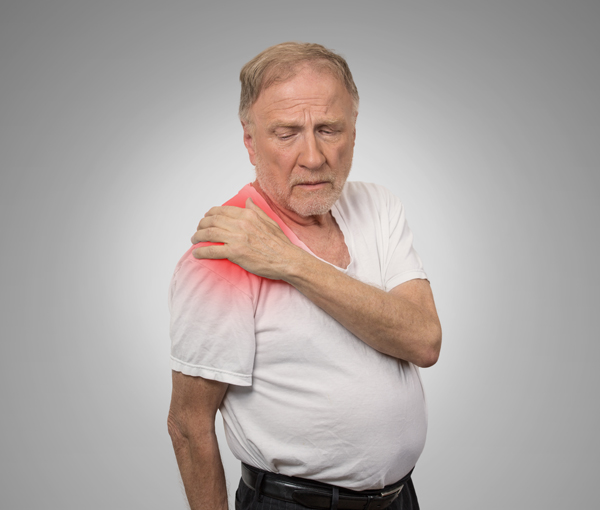There are four basic types of shoulder replacements: hemiarthroplasty (also known as a partial shoulder replacement); resurfacing arthroplasty; traditional, or anatomic, total shoulder replacements; and reverse total shoulder replacements. Hemiarthroplasty and resurfacing arthroplasty are used in specific, limited circumstances. Reverse shoulder arthroplasty is used mostly in patient with arthritis when the rotator cuff is not intact, patients with massive irreparable rotator cuff tears with pseudo-paralysis (inability to lift the arm above 90 degrees), and many revision and deformity situations. This post will specifically address anatomic total shoulder replacements, with a post about reverse shoulder replacements to come later.
Most shoulder replacements are done when arthritis of some kind — rheumatoid, osteoarthritis, psoriatic, or post-traumatic — causes significant pain or limitations in shoulder function. Before shoulder replacement surgery, Dr. Nolan will usually recommend more conservative treatment options, including activity modification, anti-inflammatory medications or steroid injections, physical therapy, and other non-invasive treatment options. Some patients may not find relief with any of the non-invasive treatments, however, and will then proceed to total shoulder replacement surgery.
The rotator cuff, or the muscles and tendons that keep the ball-and-socket joint between your arm and shoulder blade functioning, must be intact for an anatomic total shoulder replacement to function correctly and to avoid early loosening. The shoulder replacement surgery is typically a one- to two-hour procedure, but it could be longer in some circumstances if there is additional work required, such as bone grafting. During the procedure, a prosthesis is used to replace the head of the humerus bone (ball portion of the ball-and-socket joint) and the socket (glenoid) of the shoulder joint. The ball is typically made of cobalt chrome, while a medical-grade plastic (polyethylene) is used for the glenoid portion. Most total shoulder replacements can be done with an approximately five-inch scar on the front area of the shoulder.
Most patients stay in the hospital for one night following surgery, but some patients may stay longer. Before being discharged from the hospital, you will see a physical therapist to learn how to take your sling on and off and learn tips for getting dressed and doing daily tasks without injuring your shoulder as it heals. Upon going home, you will be able to do things with your hand on the operative arm like talking on your phone and feeding yourself, but may need someone available to help you with getting dressed, showering, cooking, and other daily tasks, typically for a week or two following surgery.
About two weeks after surgery, you will have a post-operative appointment with Dr. Nolan. If everything looks good in terms of the incision healing, most patients will start a three-month course of physical therapy two or three times per week. Some patients may continue physical therapy for up to an additional three months. We can help you locate a physical therapist near home or work so that you can make it to therapy appointments frequently, as regular therapy is essential for full recovery from total shoulder replacement.
Many patients want to know when they can return to work or other activities following surgery. For patients who work desk jobs, we recommend taking a full two weeks off to recover, make sure the incision is healing properly, and get scheduled for physical therapy. You will be in a sling for approximately six weeks after surgery. For patients who work manual labor jobs, additional time off work will likely be required to allow your shoulder to fully heal. For those who do heavy lifting at work, expect to take at least three months off work. Sports activities should generally wait for three to six months after surgery, depending on your progress in physical therapy and the type of activity you want to do. We recommend avoiding contact sports and activities where you risk falling from a height, such as riding a horse or working on roofs indefinitely following shoulder replacement surgery.
Some individuals are not good candidates for total shoulder replacement surgery, including anyone with an active infection, those who are too weak or ill for anesthesia, diabetics with A1c levels that are not well controlled, individuals who do a lot of heavy lifting that may compromise the implant, and individuals who work at high elevations (such as roofers), and those who are at high risk of falls (such as people with Parkinson’s disease). Heavy lifting and falling from a high elevation or falling shortly after surgery create risk of breaking the implant, breaking the surrounding bones, or injuring the muscles and tendons. If any of those occur, surgery may be required to repair the shoulder, and each additional surgery has a lower success rate. Dr. Nolan will discuss all of these factors with you to determine whether or not you are a good candidate for a total shoulder replacement.
If you are experiencing significant pain or limited function of your shoulder and wonder if you might be a candidate for a total shoulder replacement, call the Oklahoma Shoulder Center today to schedule a consultation appointment.
By Oklahoma Shoulder Center PLLC
May 15, 2017

Blog Posts

